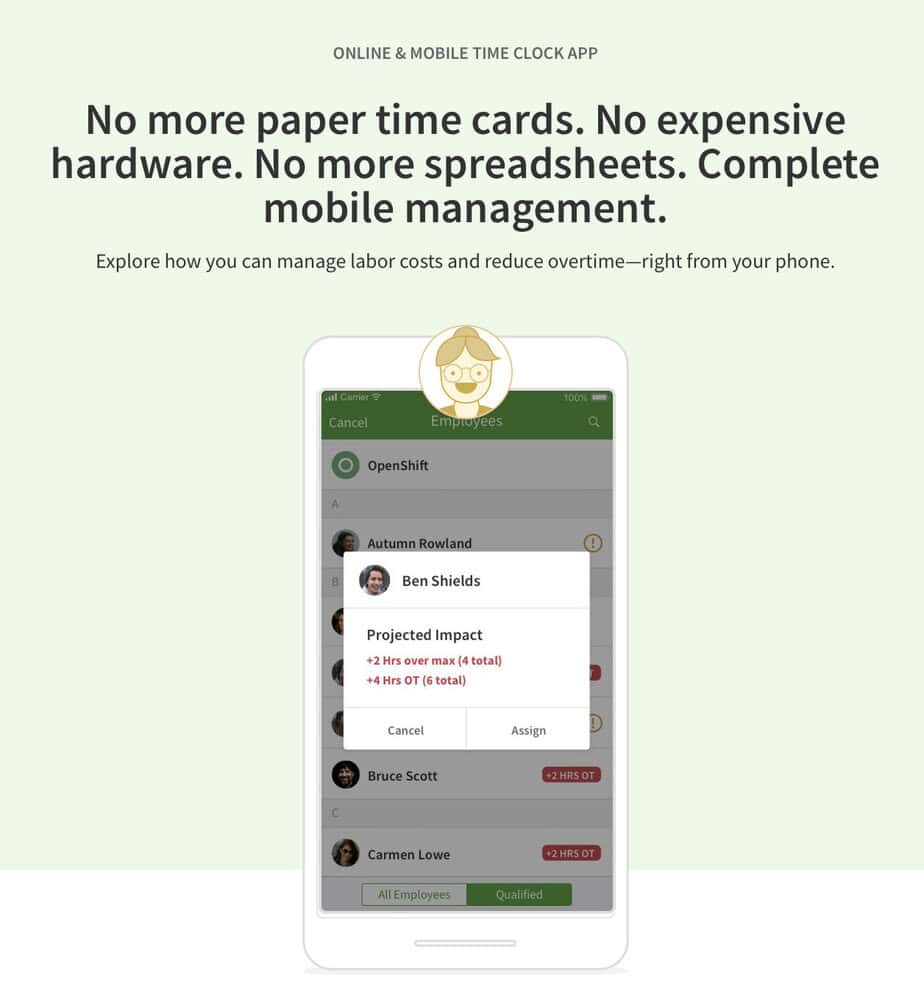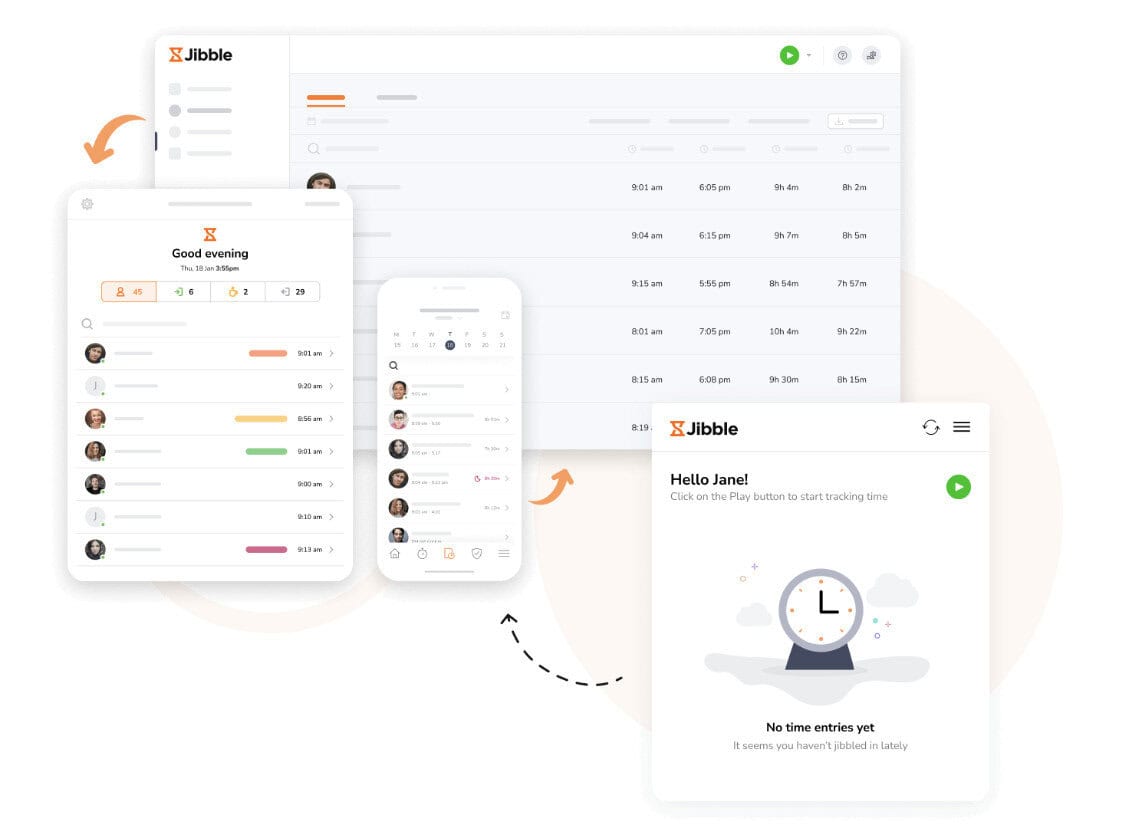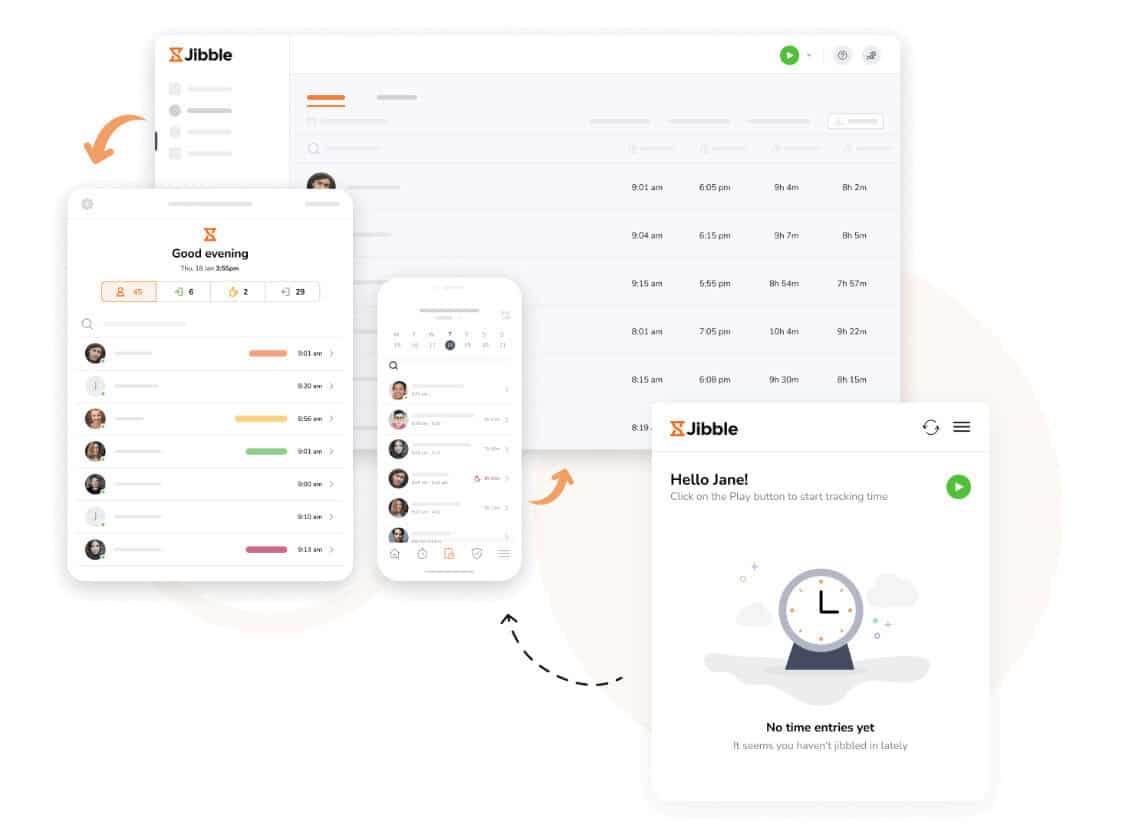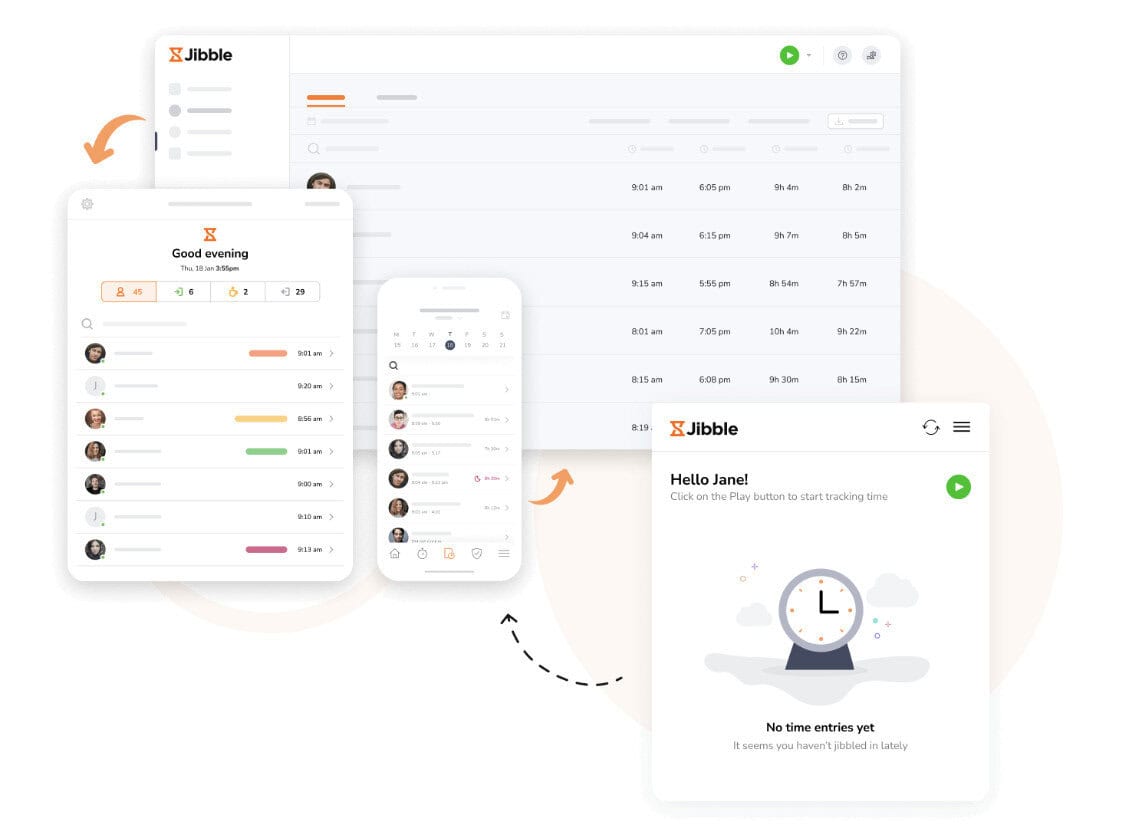- At a Glance: Best Time Card Apps in 2025
- What Are Time Card Apps?
- Why Time Card Apps Are Worth It
- What to Look for in a Time Card App
- My Picks for the Best Time Card Apps
- 1. Homebase
- 2. When I Work
- 3. Buddy Punch
- 4. Clockify
- 5. Jibble
- 6. QuickBooks Time
- 7. Harvest
- 8. Hubstaff
- 9. Connecteam
- 10. Fareclock
- Use Cases Summary: Who Should Choose Which Time Card App?
- FAQs About Time Card Apps
- My Final Thoughts: Clock In With the New Way
Last Updated on November 5, 2025 by Ewen Finser
Paper punch cards were never great. They smudge, they get “lost,” and if you’ve ever had to reconcile a week’s worth of handwritten timesheets, you know the special kind of rage it inspires. Spreadsheets didn’t make things much better. I mean, one accidental or fat-fingered keystroke and suddenly Carla in Sales is billing 90 hours a week.
And that’s why I love time card apps. They don’t just digitize old systems; they completely rethink how you track, verify, and pay for work. These apps are lifesavers with facial recognition that stops “buddy punching” and payroll integrations that mean no more late Friday-night math marathons.
I’ve tested and compared the most popular time card apps out there. Some are built for shift-based chaos, others for freelancers, and others for remote-first companies that live on Zoom.
Whatever your team setup, one of these tools will keep you sane and your payroll accurate.
At a Glance: Best Time Card Apps in 2025
Here’s the quick-and-dirty table if you don’t have time to read the whole roundup.
Tool | Best For | Standout Features | Free Trial | Pricing |
Homebase | SMBs needing an all-in-one | Free plan, scheduling, payroll integration, and compliance tools | 14 days | Free, or paid plans starting from $30/location/mo |
When I Work | Shift-heavy workplaces | Auto-scheduling, labor cost controls, and GPS time clock | 14 days | $2.50–$5/user/mo |
Buddy Punch | Teams battling buddy punching | Facial recognition, geofencing, and PTO tracking | 14 days | From $5.49/user/mo |
Clockify | Freelancers & small agencies | Unlimited free plan, detailed reporting, and project tracking | 7 days | Free, or starts at $4.99/user/mo |
Jibble | International teams & startups | Free plan, mobile-first, and facial recognition | 14 days | Free, or starts at $4.99/user/mo |
QuickBooks Time | Teams tied to QuickBooks | GPS clock-ins, project tracking, and payroll sync | 30 days | From $20 base + $8/user/mo |
Harvest | Agencies and billable work | Time tracking, invoicing, and integrations galore | 30 days | $13.75/user/mo |
Hubstaff | Remote & distributed teams | Productivity tracking, payroll automation, and screenshots | 14 days | $7–$25/user/mo |
Connecteam | Deskless & enterprise teams | Mobile-first hub, scheduling, and HR management | 14 days | Free, or starting from $29/month for the first 30 users |
Fareclock | Construction & field work | GPS, job costing, and facial recognition | 30 days | From $19.50/mo + $12 base and per-user fee |
Quick heads-up: These prices are the straight monthly rates; no annual lock-ins or discounts are factored in.
What Are Time Card Apps?
Time card apps are the digital evolution of the old punch clock by the factory door. At their simplest, they record clock-ins and clock-outs. But these days, the best apps go way beyond: think GPS-enabled mobile check-ins, automated timesheets, overtime alerts, and integrations with payroll, accounting, or project management tools.
They’re also built for the way we actually work now. With employees split between job sites, retail floors, home offices, and coffee shops, paper cards or spreadsheets just can’t keep up.
A modern time card app gives managers real-time visibility into who’s working, where, and for how long, without chasing texts or emails. Many apps even flag compliance issues, send reminders for breaks, and prevent early clock-ins that increase labor costs.
If you’ve ever had someone swear they “forgot” to clock out, or you’ve manually typed hours into QuickBooks at midnight, you already know why these exist.
Why Time Card Apps Are Worth It
If you’re wondering whether it’s really worth swapping spreadsheets for software, the answer is a definite yes.
Here’s why time card apps pay for themselves almost immediately:
- Payroll accuracy: Hours flow straight into payroll, cutting out late-night math errors.
- Compliance confidence Digital records and audit trails keep you covered for labor laws.
- Fewer disputes Employees and managers can see clear, verified timesheets.
- Productivity visibility GPS, scheduling, and reporting tools show where time (and money) really go.
- Scalability Whether you’ve got five employees or fifty, apps scale without adding admin headaches.
The kicker is that most businesses don’t realize how much time they lose until they automate.
A single payroll dispute can eat up hours of back-and-forth, not to mention the trust it erodes. For small teams, one mistake can be more expensive than a month of software. For larger or distributed crews, real-time visibility prevents hidden costs from snowballing.
What to Look for in a Time Card App
We all know by now that not every app is the same, and the right choice really depends on your team and workflow.
Here’s what matters most when you’re choosing the best time tracking app for your team:
- Ease of use: If your team can’t figure it out quickly, they won’t stick with it. The best apps feel intuitive from day one, so you can skip the long demos and get straight to tracking
- Features: Look for GPS, facial recognition, PTO tracking, and payroll integrations that match your actual needs.
- Pricing model: Per-user vs. per-location pricing can swing costs dramatically as you scale. And don’t skip the free trial. It’s way better to find out that the app’s a dud in a week than untangling it from your payroll later.
- Employee buy-in: Apps that feel too much like surveillance tend to flop; the best ones balance accountability with trust. Nobody likes a “big brother” time clock, so pick a tool your team won’t hate logging into every day.
- Support & integrations: Strong integrations with payroll, HR, or project tools save you hours, and responsive support matters when tech hiccups hit.
The trick is finding the sweet spot between functionality and simplicity. Overly complex systems frustrate staff, while bare-bones tools won’t keep pace as your business grows.
My Picks for the Best Time Card Apps
I’ve put the leading time card apps through their paces. Here’s the breakdown of the best, and how they stack up depending on your business needs.
1. Homebase
Best for SMBs needing an all-in-one solution

If you want one app that does scheduling, time tracking, payroll, and compliance without making you cry at the monthly bill, Homebase is it. The free plan covers a ton, from scheduling and messaging to basic time tracking, which is almost unheard of in this category.
When I tested it, what stood out was how smooth the experience was. Employees could clock in from their phones, managers got alerts if someone was late, and payroll ran without me needing to cross-check a spreadsheet three times.
I’ve also tested other payroll tools that promised automation but still required jumping between systems. Homebase completely changed that. Everything—scheduling, time tracking, and payroll—happens in one place, with no manual syncing or exporting timesheets.
It automatically handles overtime, breaks, and tips, and even flags tax or compliance issues before they become problems. The setup was simple, with real onboarding help, and once it was running, payroll became something I didn’t have to think about. For small business owners, that level of accuracy and automation makes a world of difference.
It’s clearly built for restaurants, retail shops, and small service businesses where no one has time to babysit a clunky system. However, that doesn’t mean you can’t use Homebase if your business doesn’t serve lattes or run a cash register.
Key features:
- Free plan for up to 10 employees and one location
- Payroll and compliance tools
- Scheduling and team communication built in
- GPS and geofencing for accurate time tracking
Pricing snapshot: Free plan available; paid tiers from $30/location/month with various add-ons and a 14-day free trial.
2. When I Work
Best for shift-heavy workplaces

Scheduling chaos? This one’s for you. When I Work was designed for restaurants, healthcare, and retail teams where shifts swap constantly. The auto-scheduling feature was a lifesaver in my testing: one click and the app built a schedule that didn’t blow my labor budget.
Employees loved being able to swap shifts in-app, and I loved not being texted at 10 p.m. (or later) about it. Time clock integration with GPS meant I could see when someone clocked in at the right job site, cutting down on the “oops, I forgot to clock out” messages.
Key features:
- One-click scheduling and auto labor forecasting
- GPS-enabled mobile clock-ins
- Real-time shift swaps and confirmations
- Payroll integrations for fast processing
Pricing snapshot: 14-day trial; paid plans from $2.50–$5/user/month.
3. Buddy Punch
Best for stopping buddy punching dead in its tracks

The name says it all. Buddy Punch is built to stop employees from clocking in for each other. Features like facial recognition and geofencing worked surprisingly well in my test, and there was no way to fudge it.
It’s also a pretty full-featured time card app beyond just security, with PTO tracking, overtime alerts, and integrations with most payroll providers. I’d recommend it for teams where trust issues around time tracking have been… let’s say, a problem.
Key features:
- Facial recognition and photo clock-ins
- GPS and geofencing
- PTO and overtime management
- Payroll integrations
Pricing snapshot: Free 14-day trial available; paid plans start at $5.49/user/month plus a monthly base fee and various add-ons.
4. Clockify
Best for freelancers and small agencies

Clockify is the darling of freelancers everywhere, mostly because its free plan is unlimited. You can track time across projects and create reports, without paying a cent.
When I tried it, I liked how easy it was to set up separate projects and billable rates. The reporting isn’t flashy, but it gets the job done. If you’re running an agency or billing hourly, Clockify makes it dead simple to prove where your time went.
Key features:
- Unlimited free plan
- Project and task tracking
- Custom billable rates
- Simple reports and exports
Pricing snapshot: Free forever plan; paid tiers from $4.99/user/month.
5. Jibble
Best for international teams & startups

Jibble feels like the scrappy younger sibling in this space. It’s mobile-first, but you can track time on your desktop or with the Chrome Time Tracker. It also offers a very generous free plan and includes neat extras like facial recognition for attendance.
When I tested it, the mobile app was snappy, and my team could figure it out quickly. It’s especially good for startups or teams working across borders since pricing stays affordable, and it works well across devices.
Key features:
- Free plan with unlimited users
- Mobile-first design
- Facial recognition clock-ins
- Project and payroll integrations
Pricing snapshot: Free forever plan; paid tiers from $4.99/user/month.
6. QuickBooks Time
Best for teams already living in QuickBooks

If you’re already using QuickBooks for payroll and accounting, this is a no-brainer. The integration is seamless. GPS clock-ins worked well in my test, and project tracking felt built for job sites and field crews.
The downside? Pricing adds up quickly since you pay a base fee and per user. But for companies tied into the QuickBooks ecosystem, it’s worth it just to avoid data entry nightmares.
Key features:
- Deep QuickBooks integration
- GPS-enabled clock-ins
- Job and project tracking
- Alerts for overtime and missed punches
Pricing snapshot: Base fee $20/month + $8/user/month for 1 admin.
7. Harvest
Best for agencies & billable projects

Harvest has been around forever in freelancer/agency land, and for good reason. It blends time tracking with invoicing and project management.
In my test, I liked how invoices pulled directly from tracked hours, so there’s no more juggling spreadsheets and billing software. For client-facing teams, this is the one I’d trust to keep projects profitable and billing accurate.
Key features:
- Time tracking and invoicing
- Project and expense tracking
- Detailed reporting
- Integrations with 65+ tools
Pricing snapshot: Free trial available; free forever plan for one user with two projects, and paid plans start at $13.75/user/month.
8. Hubstaff
Best for remote & distributed teams

Hubstaff is polarizing because of its productivity monitoring: it can take screenshots, track URLs, and measure “activity levels.” Personally, I found the reporting useful, but I’d only deploy it where trust issues exist or visibility is critical.
For remote-first companies, it’s a powerhouse: real-time dashboards, payroll automation, and integrations with tools like Asana and Slack. In testing, I found it made managing a global team a lot less stressful.
Key features:
- Productivity and activity tracking
- Optional screenshots and app tracking
- Automated payroll and 35+ integrations
- Advanced reporting and budgeting tools
Pricing snapshot: Paid plans from $7–$25/user/month, with optional add-ons.
9. Connecteam
Best for deskless & enterprise teams

Connecteam is more than just a time card app; it’s a full-on workforce management platform. It’s built for big, deskless teams, from those who work in the construction and logistics industry to those in field services.
The mobile-first interface impressed me. My test crew clocked in from job sites without issue. Managers get real-time labor cost data, and the all-in-one hub means you can also run scheduling, HR tasks, and communication in the same place.
Key features:
- All-in-one workforce hub
- Scheduling, HR, and communication
- GPS-enabled time tracking
- Affordable pricing for larger teams
Pricing snapshot: Free plan available; paid tiers from $29/month for the first 30 users.
10. Fareclock
Best for construction & field work

Fareclock is a niche player, but it nails the construction/manufacturing space. With features like facial recognition, GPS tracking, and job costing, it’s perfect if you need to prove labor hours on specific job sites.
When I tested it, I liked how visual and straightforward the interface was. Payroll export to QuickBooks worked seamlessly, and job costing reports felt tailor-made for construction crews.
Key features:
- Facial recognition and anti-buddy punching
- GPS geofencing
- Job costing and compliance features
- QuickBooks and payroll integrations
Pricing snapshot: Free 30-day trial; paid plans from $19.50/month with a $12 base and $1.50/user fee.
Use Cases Summary: Who Should Choose Which Time Card App?
Still not sure which app is right for you?
Here’s my cheat sheet, with the best fit and a quick reason why:
- SMBs & retail/service shops → Homebase or When I Work
Easy scheduling and payroll without drowning in admin.
- Shift-based businesses → When I Work or Buddy Punch
Designed for constant shift swaps and stopping time theft.
- Freelancers & agencies → Clockify or Harvest
Clockify wins on “free forever,” while Harvest nails invoicing.
- Remote/distributed teams → Hubstaff
Real-time visibility into productivity without endless check-ins.
- Deskless & enterprise teams → Connecteam
A true workforce hub built for scale and mobile crews.
- Construction & field industries → Fareclock or QuickBooks Time
GPS, job costing, and compliance features for job-site accuracy.
FAQs About Time Card Apps
Question: Are time card apps legally valid?
Answer: Yes. As long as records are accurate and accessible, digital timekeeping is compliant with labor laws. Many apps even include built-in compliance tools.
Question: Which time card apps are free?
Answer: Clockify, Jibble, and Homebase all have free plans that cover unlimited users (with varying feature limits).
Question: Can time card apps prevent buddy punching?
Answer: Yes; apps like Buddy Punch and Fareclock use facial recognition, GPS, or photo verification to eliminate it.
Question: How do time card apps integrate with payroll?
Answer: Most major apps connect directly to providers like QuickBooks, ADP, or Gusto. It means tracked time flows straight into payroll, cutting down on errors.
Question: What’s the easiest app for employees to adopt?
Answer: In my testing, Homebase, Clockify, and When I Work had the smoothest onboarding. These have intuitive mobile apps that employees actually like using.
My Final Thoughts: Clock In With the New Way
Nobody’s nostalgic for paper punch cards or messy spreadsheets, and after testing these apps, I can’t imagine going back. Each of the tools here solves a different flavor of time-tracking chaos: whether it’s buddy punching, shift madness, or payroll disputes.
The real win, though? Peace of mind. Once you roll out the right app, the late-night payroll math, the “I swear I worked those hours” debates, and the constant back-and-forth with managers pretty much vanish.
Pick the app that fits your team’s quirks and size, get everyone on board, and let the software handle the grunt work. You’ll save money, but more importantly, you’ll save your sanity.

